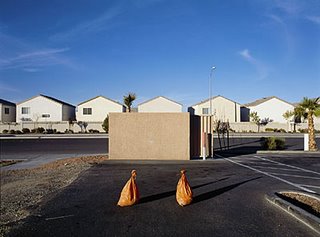
Are housing prices forcing people into the "exurbs" or is it the quality of life - less pollution, less people, more open space, bigger homes, etc.? Or both? But if one drives three to six hours per day to and from work, could that be measured as a good quality of life? I thought one needs to experience that lifestyle in order to enjoy it. Spending 18 to 30 hours a week in an automobile might detract from time spent in one's community, minimize time spent with family, etc. With gas prices climbing, it seems that people will not be deterred from the long drive.
'The rat race is turning into a marathon. Inside the lives of 'extreme commuters.'
By Keith Naughton
Newsweek
At 5:40 a.m., the alarm blares news-talk radio and Bill Small rolls out of bed. With a two-hour commute ahead of him, the Chicago doctor wastes little time. He showers, dresses and is out the door by 6. At this hour, his car is the only one navigating the winding streets of his upscale neighborhood in St. Charles, Ill., a quaint community nearly 50 miles west of the Chicago hospital where he works. Small's routine is so finely tuned that he won't stop for coffee if there are more than three cars in the drive-thru. Today there are just two, and he picks up an extra-large. But there's no time for a bathroom break, so Small, 41, won't allow himself a single sip for nearly an hour. At the halfway mark, he takes his first swig as he hits gridlock on the Eisenhower Expressway. With the sun rising over the Chicago skyline, he crawls along, placidly listening to sports radio. Finally, he arrives at exactly 8 a.m. Though he won't return home for 12 and a half hours, Small still says the killer commute to and from exurbia is worth it. "It's a nice place to raise kids," he says. "And it does feel like you're away."
The drive to get away from it all is turning us into a nation of nomads. As we're pushed to the edge of civilization by runaway home prices and a longing for wide-open spaces, the daily rat race is turning into a marathon. "Extreme commuters" who travel more than 90 minutes to work, one way, are the fastest-growing group of commuters, according to the U.S. Census Bureau. More than 3.4 million commuters take that long road to work every day, double the rate of extreme commuters in 1990. And the fastest-growing departure time is now between 5 and 6 a.m. Even $3-a-gallon gas and growing gridlock aren't slowing the rise of this group, which is changing the way we live as we spend more time in our cars and less time in our communities. This endless commute is becoming the defining characteristic of the 21st-century working stiff. So much of what we worry about today—volatile real-estate prices, sleeplessness, our overstressed lives—all merge together on the road, as we search for the elusive simple life in some suburban Shangri-La. "We're obsessed with the commute," says Joy Mander, 42, a nurse who drives 45 miles to work the over-night shift at Children's Hospital in Oakland, Calif. "How much is it worth to own your own home if you end up spending four hours on the road and not playing with your kids, not sleeping enough and rotting in traffic?"
It's apparently worth plenty, because more people than ever are willing to trade time in their car for the American Dream: big house, big yard. Nearly 10 million people now drive more than an hour to work, up 50 percent from 1990. The average commute today is 25 minutes, up 18 percent from two decades ago. What drives us to drive so far? Many are doing what California real-estate agents call "driving 'til you qualify." New-home prices have nearly tripled in the past 20 years and now average almost $300,000, according to the National Association of Home Builders. In places like southern California, each exit along the interstate saves you tens of thousands of dollars. That's why Chris Neelley, 43, lives in Lancaster, Calif., and drives 80 miles to L.A. every day. For $400,000 last year, he moved his family of five into a 3,000-square-foot home, twice the size of the place they used to have closer to the city. The trade-off: he now spends three to six hours a day on the road. "I love being out in the middle of nowhere," he says, "and seeing no people around."
But for many people, the long and winding road isn't leading to the exurban bliss. With everyone stuck in traffic, it turns out there's no one around to coach Little League or volunteer for the PTA, not to mention get dinner on the table. Robert Putnam, author of "Bowling Alone," found that every 10 minutes added to your commute decreases by 10 percent the time you dedicate to your family and community. And having parents so far from home creates logistical challenges for local officials. "We're really worried about what happens in an earthquake," says John Brooks, an economic analyst in Palmdale, Calif., a booming bedroom community 65 miles north of L.A. "All the parents are down below, and we've got tens of thousands of their kids up here to take care of."